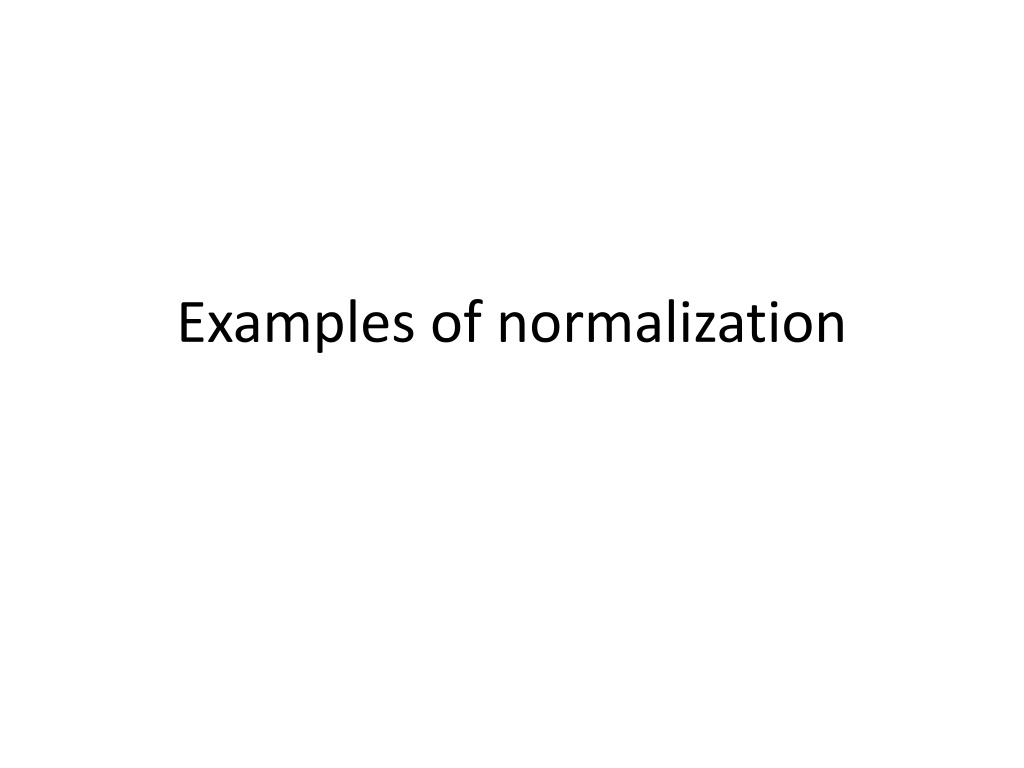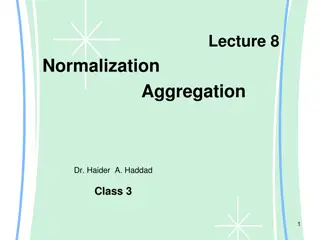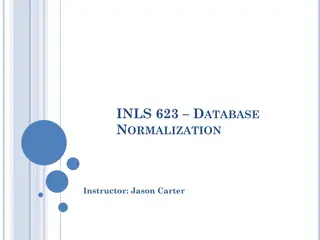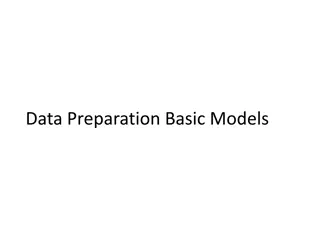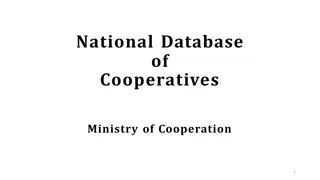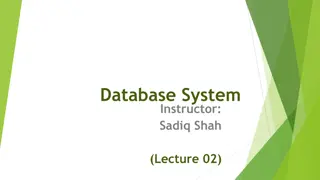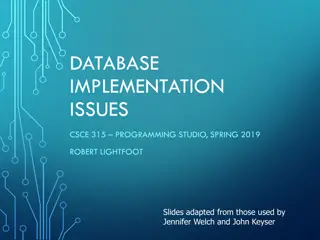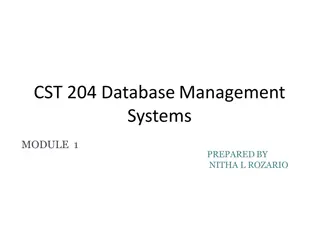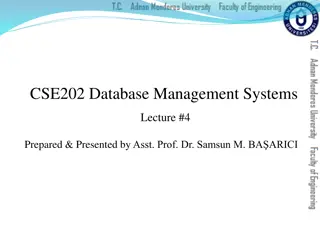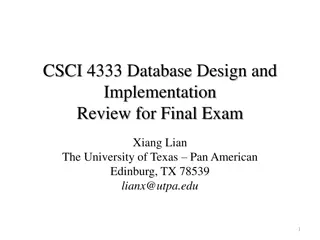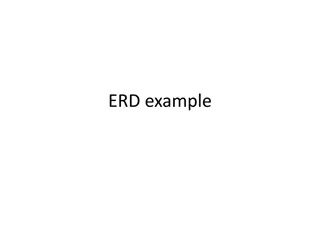Understanding Database Normalization Process
Database normalization is a crucial process that helps in organizing data efficiently by reducing redundancy and dependency issues. It involves steps like identifying keys, removing repeating attributes, and transforming data into different normal forms. Each step aims to enhance data integrity and optimize database performance.
Download Presentation

Please find below an Image/Link to download the presentation.
The content on the website is provided AS IS for your information and personal use only. It may not be sold, licensed, or shared on other websites without obtaining consent from the author. Download presentation by click this link. If you encounter any issues during the download, it is possible that the publisher has removed the file from their server.
E N D
Presentation Transcript
Example1 Step 1 Identify a key for the table. Remove duplicate data
Step 2 Transform a table of unnormalised data into first normal form (1NF). any repeating attributes to a new table. A repeating attribute is a data field within the UNF relation that may occur with multiple values for a single value of the key. The process is as follows: Identify repeating attributes. Remove these repeating attributes to a new table together with a copy of the key from the UNF table. Assign a key to the new table . The key from the original unnormalised table always becomes part of the key of the new table. A compound key is created. The value for this key must be unique for each entity occurrence.
In the previous table the Project Title, Project Manager, Project Budget are repeating. That is, there is potential for more than one occurrence of these attributes for each project code. These are the repeating attributes and have been to a new table together with a copy of the original key (ie: Project Code).
1NF Tables: Repeating Attributes Removed
Step 3 Transform 1NF data into second normal form (2NF). Remove any -key attributes (partial Dependencies) that only depend on part of the table key to a new table. What has to be determined "is field A dependent upon field B or vice versa?" This means: "Given a value for A, do we then have only one possible value for B, and vice versa?" If the answer is yes, A and B should be put into a new relation with A becoming the primary key. A should be left in the original relation and marked as a foreign key. Ignore tables with (a) a simple key or (b) with no non-key attributes (these go straight to 2NF with no conversion). The process is as follows: Take each non-key attribute in turn and ask the question: is this attribute dependent on one part of the key? If yes, remove the attribute to a new table with a copy of the part of the key it is dependent upon. The key it is dependent upon becomes the key in the new table. Underline the key in this new table. If no, check against other part of the key and repeat above process If still no, ie: not dependent on either part of the key, keep attribute in current table.
The first table went straight to 2NF as it has a simple key (Project Code). Employee name, Department No and Department Name are dependent upon Employee No only. Therefore, they were moved to a new table with Employee No being the key. However, Hourly Rate is dependent upon both Project Code and Employee No as an employee may have a different hourly rate depending upon which project they are working on. Therefore it remained in the original table.
Step 4 data in second normal form (2NF) into third normal form (3NF).Remove to a new table any non-key attributes that are more dependent on other non-key attributes than the table key. Ignore tables with zero or only one non-key attribute (these go straight to 3NF with no conversion). The process is as follows: If a non-key attribute is more dependent on another non-key attribute than the table key: Move the dependent attribute, together with a copy of the non-key attribute upon which it is dependent, to a new table. Make the non-key attribute, upon which it is dependent, the key in the new table. Underline the key in this new table. Leave the non-key attribute, upon which it is dependent, in the original table and mark it a foreign key (*).
The project team table went straight from 2NF to 3NF as it only has one non-key attribute. Department Name is more dependent upon Department No than Employee No and therefore was moved to a new table. Department No is the key in this new table and a foreign key in the Employee table.
Summary of Normalization Rules That is the complete process. Having started off with an unnormalised table we finished with four normalized tables in 3NF. You will notice that duplication has been removed (apart from the keys needed to establish the links between those tables). The process may look complicated. However, if you follow the rules completely, and do not miss out any steps, then you should arrive at the correct solution. If you omit a rule there is a high probability that you will end up with too few tables or incorrect keys. The following normal forms were discussed in this section: First normal form: A table is in the first normal form if it contains no repeating columns. Second normal form: A table is in the second normal form if it is in the first normal form and contains only columns that are dependent on the whole (primary) key. Third normal form: A table is in the third normal form if it is in the second normal form and all the non-key columns are dependent only on the primary key. If the value of a non-key column is dependent on the value of another non-key column we have a situation known as transitive dependency. This can be resolved by removing the columns dependent on non-key items to another table.
Example2 UNF In this Relation (STUDENT _REPORT ) St.No Name Address SuCode Subject Hours TechNo Teacher Department Grade Introduction to computer 5 Fahad Riyadh csc101 3 7 Ali Computer A Itroduction to Calculation math1 02 5 Fahad Riyadh 4 12 Saad Math B C++ 5 Fahad Riyadh csc103 4 2 Rashid Computer C+ DB1 5 Fahad Riyadh csc325 3 2 Khalid Computer B+ DB2 5 Fahad Riyadh csc426 3 3 Tariq Computer B / 13
1NF Relation STUDENT St.No Name Address Relation STUDENT Report St.No SuCode Subject Hours TechNo Teacher Department Grade / 14
2NF Relation STUDENT St.No Name Address Relation STUDENT -Subject St.No SuCode Grade Relation Subject -Teacher SuCode Subject Hours TechNo Teacher Department / 15
3NF Relation STUDENT St.No Name Address Relation STUDENT -Subject St.No SuCode Grade Relation Teacher-Subject SuCode Subject Hours TechNo Relation Teacher TechNo Teacher Department / 16
Example3 Stdno Course_no Mark CourseName StdName FD1 FD2 FD3 Describe and illustrate the process of normalization to produce 2NF relations.
Example4 A B C D E FD1 FD2 FD3 FD4 Describe and illustrate the process of normalization to produce 3NF relations.
Example5 StudentID StudentName CampusAddress Major CourseID CourseTitle InstructorName Instructor_ Location Grade Put this relation in the 3NF.
